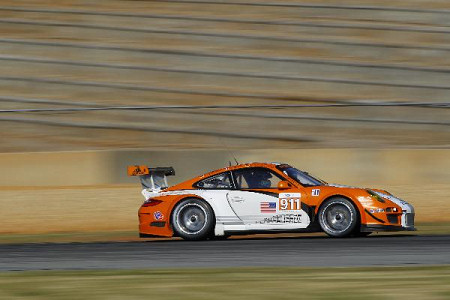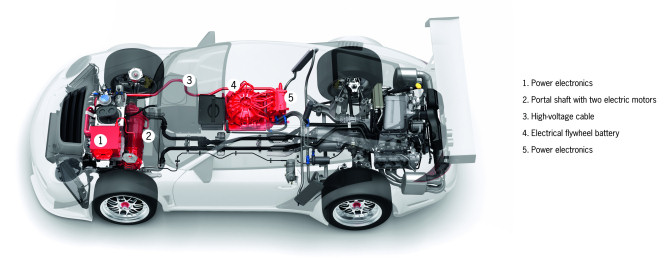The Way It Is/ Looking at Porsche's 911 GT3 R hybrid
by Gordon Kirby
©
The 911 GT3 R made its debut last month in the Nurburgring 24 hours and led the race until an eleventh-hour failure. The car next raced earlier this month at the Petit Le Mans at Road Atlanta where it ran the full distance without any problems and proved to be competitive with the existing GT2 cars. Porsche's hybrid 911 races once again on November 7th in the 1,000K Intercontinental Cup race at Zuhai, China, where it will be driven by ALMS GT2 driving champions Patrick Long and Jorg Bergmeister.
During the Petit Le Mans weekend at Road Atlanta a press briefing about the 911 GT3 R was staged by Porsche's top racing and engineering men. Hartmut Kristen, Porsche's head of motor sport, commented on the 911GT3 R's design and development process.
"The decision was made to go ahead with the hybrid project in 2008 and about the end of that year we had all the hardware components available to put them into the car," Kristen said. "We knew how we wanted to integrate them into the car and we took from early in 2009 until May of this year to get the car ready for the Nurburgring 24 hours. After the Nurburgring we had to analyse all the data, which was really quite a lot, and then we set up a plan how to continue. After Road Atlanta and Zuhai in November we will continue to analyse the data and work on the development program."

© Courtesy of Porsche Cars North America, Inc.
"As we start to develop electric technology for road cars we will not end up with an unexciting electric car," Duerheimer stressed. "We will do emotion, passion and high performance, as we are used to, and we will end up with race cars and high performance cars that fit into the portfolio of our brand. Bringing hybrid technology to motor racing will help us to boost our performance and efficiency even further.
"The 911 GT3 hybrid racing car is the best example that high performance and outstanding efficiency are not mutually exclusive. Quite the opposite, because in endurance motor racing efficiency is the key to success."
Duerheimer and his colleagues emphasized the direct technology transfer between the 911 GT3 R and both the latest Cayenne S road vehicle and Porshe's coming high performance 918 sports car.
"The same principle also applies to the hybrid version of the new Cayenne generation," Duerheimer said. "The Cayenne S hybrid has a V-6 supercharged engine which combines the performance of an eight-cylinder with the fuel efficiency of a six-cylinder. The difference in this case is the parallel full hybrid technology which has been exclusively designed for the Cayenne hybrid.
"If you combine both hybrid technology, the performance-oriented hybrid technology of the 911 GT3 R hybrid and the efficiency-oriented hybrid technology of a Cayenne into an overarching interdisciplinary concept what you get is Porsche intelligent performance in its most attractive and efficient form. And that is the future Porsche 918 Spyder which combines with the performance of a racing car and the emissions of a compact car."
Dr. Jacob Neusser, Porsche's director of drivetrain development, expanded on Duerheimer's comments about the technology transfer between the 911 GT3 R, the Cayenne S hybrid, the 918 supercar and the latest version of the Panamera which will also include a full hybrid powertrain.
"It's important to see the amazing impact of the engineering side with the new hybrid components because we are not concentrating on only the fuel economy of the car we are also focusing on improving the performance," Dr. Neusser said. "The motivation for the production car is a significant reduction in fuel consumption but also the dynamic driving performance and improvement of the typical driving pleasure preferred by our customers. With the 918 we want to combine both the qualities from the race hybrid system with the qualities of the production car into one new car".
Like the 911 GT3 R the 918 will feature a pair of electric motors to drive the front wheels and a 160 KW electric motor at the rear to supplement a conventional 500 horsepower V-8 combustion engine. The 918 will accelerate from 0-60 mph in two seconds with a top speed of almost 200 mph. It will be capable of averaging more than 70 mpg and running fifty miles on strictly electric power.
Dr. Neusser commented on the development program of the 911 GT3 R's hybrid system and how the race car has different driving requirements than the Cayenne S road car.
"The most complex system of the 911 GT3 R is the hybrid module which contains the disengagement clutch which opens the power train and enables you to declutch the engine and the power train to enjoy complete electric drive," Dr. Neusser observed. "You have a weight of 55 kilograms and the power is 34 Kilowatts with a voltage of 280 volts.

© Courtesy of Porsche Cars North America, Inc.
Hartmut Kristen detailed the concept and development of the 911 GT3 R.
"When we talk about hybrid cars it's not only about fuel saving," Kristen said. "Fuel saving by itself is nothing that would make any Porsche driver respond enthusiastically. So our idea was how could we combine the fuel saving with efficient performance and with emotion. We thought it was obvious that the best way to do that would be to create and develop a laboratory that could race and this is what the GT3 hybrid is about.
"On the other hand we wanted to demonstrate technical leadership in the sports car segment, something that is very important in the history of Porsche. We have done that since the 959 about twenty-five years ago when people started talking about 4WD for sports cars. But at the end of the day when you look and see the cars that are coming out to the race track today we added some emotion to the hybrid technology in motor racing. This is something that is absolutely new and interesting from our point of view."
Kristen referred to the illustration of the 911 GT3 R's components.
"The important elements of the hybrid technology are highlighted in red," he said. "On the left you see the power electronics for the two electric motors that drive the front wheels and the electrical flywheel, battery, and the power electronics. The electrical flywheel is located beside the driver and everything in orange is the high voltage cable.
"One thing that is important is that the rotors are made of carbon fiber. There's a very simple reason for that. The turning speed of the flywheel is 36,000 rpm so that's about twice as much as the maximum speed of a Formula One engine and when we get to that speed it contains about 120 KW or 180 horsepower. If you compare the weight of a 120 KW engine it's very little weight for that kind of powerplant.
"The second important element with the two electric motors is they are individually responsible to drive each one of the front wheels. Combined with the electric motors, one on each side, you have a planetary transmission with a clutch to disengage the entire system. We have reduction gears which are simply necessary to step up the front axle for the specific racetrack. When we go to maximum speed the maximum power is twice the size of the Kilowatts of each electric motor."
Kristen also discussed how the driver activates the hybrid system in the 911 GT3 R.

© Courtesy of Porsche Cars North America, Inc.
"The main goal at the moment is to find the optimum working area where we can combine the best performance with the best driveability," he observed. "The driver uses the system manually to boost up and under braking the system starts to recuperate and speeds up the rotor inside the electrical flywheel. The driver can operate the system fully manually but the boost button is not necessary to use the system because it's automated. As soon as the driver accelerates he can use the conventional power at the rear and the electric power on the front as long as the flywheel is up to speed.
"We have to be careful with our focus on what's going on the racetrack to integrate the control unit of the electric motors with the conventional engine's ECU. When the driver hits the drive button he gets electric drive plus conventional drive at the same time. The driveability is something that is very important on narrow racetracks like the Nurburgring or Road Atlanta with a lot of traffic.
"You can still use the boost button in a traffic situation, or something similar, to over-ride the system by touching the boost button to give you some additional acceleration. This would mean you would lose some efficiency for sure, but that's always a trade-off. When we use the electric motors the efficiency rating is about eighty percent."
Kristen stressed that the 911 GT3 R is only the first step in Porsche's push to combine efficiency and performance in a hybrid package.
"From the beginning it was clear that one of the big challenges, not only in the hybrid race car development but also with the road car, was to make all the different systems talk to each other and be able to properly communicate. This is why we did this project because in racing we can work through all these issues much quicker than in a standard development program.
"The challenge for the future with the hybrid car is to make electric energy available and used in combination with the gasoline or diesel in our fuel tanks. This is a big challenge. We want to get a good range with the road car so we have to store a lot of energy. But on the race car we want to store energy very quickly and we want to produce it as quickly as possible. That's why we use the flywheel technology. The chance for the future will be to find ways how to combine both these things and this is what we have for the 918 Spyder.
"We want to improve everything," Kristen added. "We want to make it more powerful, lighter and integrated much better into the car. Really, we want to make everything better. If you just look at the volume, not only the weight of the components, you can easily see that too much space is taken up by these components. The length, the diameter of the electric motor, everything must be made smaller, better, more efficient with more performance."
It's great to see Porsche, Audi and the Volkswagen Group pushing the boundaries of technology and using racing as a development tool for their road cars. Sadly, American racing--NASCAR and IndyCar--have lost the plot, but there's no doubt that international motor racing and the ALMS are embracing the sport's original innovative spirit.
Porsche's hybrid racer is one of many reasons why the Petit Le Mans at Road Atlanta attracted a recored crowd of more than 124,000 fans over three days and why the ALMS has enjoyed a substantial increase this year in the all-important 18-35 age group while both NASCAR and IndyCar are losing the youth market in droves. Fortunately, the American Le Mans Series is an essential part of the sport's rebirth and I am among many fans who hope to see more cars like Porsche's 911 GT3 R hybrid competing in the ALMS in the future.
Auto Racing ~ Gordon Kirby
Copyright 2010 ~ All Rights Reserved
Copyright 2010 ~ All Rights Reserved
Top of Page